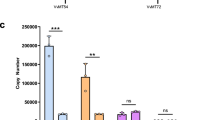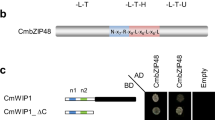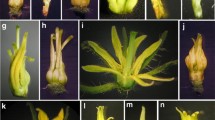Abstract
Sex determination in dioecious Silene latifolia Poir. is governed by the inheritance of heteromorphic sex chromosomes. In male plants the Y chromosome influences two aspects of male organogenesis, the continued differentiation of stamen primordia and male fertility, and one aspect of female organogenesis, the arrest of development of the pistil. S. latifolia is susceptible to infection by the parasitic smut fungus Ustilago violacea, which induces stamen development in genetically female plants. Here we describe the identification and characterisation of a novel male mutant, short stamen filaments 1 (ssf1), defective in stamen differentiation. Although several independent studies have identified genes expressed during sex-determination in S. latifolia, analyses suggest that none of these encode regulatory proteins involved in the control of sex determination. We therefore isolated six S. latifolia cDNAs encoding members of a family of transcriptional regulators, the ZPT-type Cys2/His2 zinc-finger proteins that had previously shown to be co-ordinately regulated during stamen development in Petunia × hybrida hort. Vilm.-Andr. We have analysed the genomic organisation of these genes in male and female plants and their expression dynamics in male and female plants, in smut-infected female plants and in the ssf1 mutant. Our studies reveal expression patterns during development of the androecium that suggest a possible role for SlZPT2-1 in filament elongation and SlZPT4-1 in aspects of male fertility during stamen differentiation.






Similar content being viewed by others
Abbreviations
- EMS :
-
Ethyl methanesulfonate
- PhZPT :
-
Petunia × hybrida zinc-finger protein of TFIIIA-type
- RACE :
-
Rapid amplification of cDNA ends
- SEM:
-
Scanning electron microscopy
- SlZPT :
-
Silene latifolia zinc-finger protein of TFIIIA-type
- ssf1 :
-
short stamen filaments 1
References
Antonovics J, Alexander HM (1992) Epidemiology of anther-smut Infection of Silene alba (S. Latifolia) caused by Ustilago violacea—patterns of spore deposition in experimental populations. Proc R Soc London Ser B 250:157–163
Audran JC, Batcho M (1981) Microsporogenesis and pollen grains in Silene dioica (L.) Cl. and alterations in its anthers parasitized by Ustilago violacea (Pers.) Rouss. (Ustilaginales). Acta Soc Bot Pol 50:29–33
Barbacar N, Hinnisdaels S, Farbos I, Moneger F, Lardon A, Delichere C, Mouras A, Negrutiu I (1997) Isolation of early genes expressed in reproductive organs of the dioecious white campion (Silene latifolia) by subtraction cloning using an asexual mutant. Plant J 12:805–817
Cohen AL (1979) Critical point drying: principles and procedures. In: O’Hare MF (ed) Scanning electron microscopy, vol 2. SEM Inc, Chicago, pp 303–323
Delichere C, Veuskens J, Hernould M, Barbacar N, Mouras A, Negrutiu I, Moneger F (1999) SIY1, the first active gene cloned from a plant Y chromosome, encodes a WD-repeat protein. EMBO J 18:4169–4179
Donnison IS, Siroky J, Vyskot B, Saedler H, Grant SR (1996) Isolation of Y chromosome-specific sequences from Silene latifolia and mapping of male sex-determining genes using representational difference analysis. Genetics 144:1893–1901
Farbos I, Oliveira M, Negrutiu I, Mouras A (1997) Sex organ determination and differentiation in the dioecious plant Melandrium album (Silene latifolia): a cytological and histological analysis. Sex Plant Reprod 10:155–167
Farbos I, Veuskens J, Vyskot B, Oliveira M, Hinnisdaels S (1999) Dimorphism in white campion: deletion on the Y chromosome results in a floral asexual phenotype. Genetics 151:1187–1196
Feinberg AP, Vogelstein B (1983) A technique for radiolabeling DNA restriction endonuclease fragments to high specific activity. Anal Biochem 132:6–13
Filatov DA, Moneger F, Negrutiu I, Charlesworth D (2000) Low variability in a Y-linked plant gene and its implications for Y-chromosome evolution. Nature 404:388–390
Goodfellow PN, Lovellbadge R (1993) SRY and sex determination in mammals. Annu Rev Genet 27:71–92
Grant S, Houben A, Vyskot B, Siroky J, Pan WH, Macas J, Saedler H (1994a) Genetics of sex determination in flowering plants. Dev Genet 15:214–230
Grant S, Hunkirchen B, Saedler H (1994b) Developmental differences between male and female flowers in the dioecious plant Silene latifolia. Plant J 6:471–480
Hinnisdaels S, Lardon A, Barbacar N, Negrutiu I (1997) A floral third whorl-specific marker gene in the dioecious species white campion is differentially expressed in mutants defective in stamen development. Plant Mol Biol 35:1009–1014
Kapoor S, Kobayashi A, Takatsuji H (2002) Silencing of the tapetum-specific zinc finger gene TAZ1 causes premature degeneration of tapetum and pollen abortion in Petunia. Plant Cell 14:2353–2367
Kobayashi A, Sakamoto A, Kubo K, Rybka Z, Kanno Y, Takatsuji H (1998) Seven zinc-finger transcription factors are expressed sequentially during the development of anthers in petunia. Plant J 13:571–576
Kubo K, Sakamoto A, Kobayashi A, Rybka Z, Kanno Y, Nakagawa H, Nishino T, Takatsuji H (1998) Cys(2)/His(2) zinc-finger protein family of petunia: evolution and general mechanism of target-sequence recognition. Nucleic Acids Res 26:608–615
Kubo K, Kanno Y, Nishino T, Takatsuji H (2000) Zinc-finger genes that specifically express in pistil secretory tissues of petunia. Plant Cell Physiol 41:377–382
Lardon A, Georgiev S, Aghmir A, Le Merrer G, Negrutiu I (1999) Sexual dimorphism in white campion: complex control of carpel number is revealed by Y chromosome deletions. Genetics 151:1173–1185
Lengerova M, Moore RC, Grant SR, Vyskot B (2003) The sex chromosomes of Silene latifolia revisited and revised. Genetics 165:935–938
Matsunaga S, Kawano S, Takano H, Uchida H, Sakai A, Kuroiwa T (1996) Isolation and developmental expression of male reproductive organ-specific genes in a dioecious campion, Melandrium album (Silene latifolia). Plant J 10:679–689
Matsunaga S, Kawano S, Kuroiwa T (1997) MROS1, a male stamen-specific gene in the dioecious campion Silene latifolia is expressed in mature pollen. Plant Cell Physiol 38:499–502
Nakagawa H, Ferrario S, Angenent G, Kobayashi A, Takatsuji H (2004) The Petunia ortholog of Arabidopsis SUPERMAN plays a distinct role in floral organ morphogenesis. Plant Cell 16:920–932
Ohta M, Matsui K, Hiratsu K, Shinshi H, Ohme-Takagi M (2001) Repression domains of class II ERF transcriptional repressors share an essential motif for active repression. Plant Cell 13:1959–1968
Pavletich NP, Pabo CO (1991) Zinc finger DNA recognition—crystal-structure of a Zif268–DNA complex at 2.1-A. Science 252:809–817
Robertson SE, Li Y, Scutt CP, Willis ME, Gilmartin PM (1997) Spatial expression dynamics of Men-9 delineate the third floral whorl in male and female flowers of dioecious Silene latifolia. Plant J 12:155–168
Sakai H, Medrano LJ, Meyerowitz EM (1995) Role of SUPERMAN in maintaining Arabidopsis floral whorl boundaries. Nature 378:199–203
Sambrook J, Fritsh E, Maniatis T (1989) Molecular cloning: a laboratory manual. Cold Spring Harbor Press, Cold Spring Harbor, NY
Scutt CP, Gilmartin PM (1997) High-stringency subtraction for the identification of differentially regulated cDNA clones. Biotechniques 23:468–469
Scutt CP, Gilmartin PM (1998) The Men-10 cDNA encodes a novel form of proline-rich protein expressed in the tapetum of dioecious Silene latifolia. Sex Plant Reprod 11:236–240
Scutt CP, Li Y, Robertson SE, Willis ME, Gilmartin PM (1997) Sex determination in dioecious Silene latifolia—Effects of the Y chromosome and the parasitic smut fungus (Ustilago violacea) on gene expression during flower development. Plant Physiol 114:969–979
Scutt CP, Jenkins T, Furuya M, Gilmartin PM (2002) Male specific genes from dioecious white campion identified by fluorescent differential display. Plant Cell Physiol 43:563–572
Tague BW, Goodman HM (1995) Characterization of a family of Arabidopsis zinc-finger protein cDNAs. Plant Mol Biol 28:267–279
Tague BW, Gallant P, Goodman HM (1996) Expression analysis of an Arabidopsis C2H2 zinc finger protein gene. Plant Mol Biol 32:785–796
Takatsuji H (1998) Zinc-finger transcription factors in plants. Cell Mol Life Sci 54:582–596
Takatsuji H, Matsumoto T (1996) Target sequence recognition by separate type Cys(2)/His(2) zinc finger proteins in plants. J Biol Chem 271:23368–23373
Takatsuji H, Mori M, Benfey PN, Ren L, Chua NH (1992) Characterization of a zinc finger DNA-binding protein expressed specifically in Petunia petals and seedlings. EMBO J 11:241–249
Winge Ø (1931) X- and Y-linked inheritance in Melandrium. Hereditas 15:127–163
Warmke EH, Blakeslee AF (1940) The establishment of the 4n dioecious race in Melandrium. Am J Bot 27:751–762
Westergaard M (1946) Aberrant Y chromosomes and sex expression in Melandrium album. Hereditas 32:419–443
Westergaard M (1958) The mechanism of sex determination in dioecious flowering plants. Adv Genet 9:217–281
Yampolski C, Yampolski H (1922) Distribution of sex forms in the phenerogamic flora. Bibliogr Genet 1:1–62
Ye D, Oliveira M, Veuskens Y, Wu P, Installe P, Hinnisdaels S, Truong AT, Brown S, Mouras A, Negrutiu I (1991) Sex determination in the dioecious Melandrium: the X/Y chromosome system allows complementary cloning strategy. Plant Sci 80:93–106
Acknowledgements
We thank Hiroshi Takatsuji for providing the ZPT-specific zinc finger oligos used to isolate the Silene latifolia ZPT zinc-finger protein genes described in this work. We also thank the UK Biotechnology and Biological Sciences Research Council who supported T.F.J. as a PhD student and C.P.S. and J.L. as postdoctoral researchers
Author information
Authors and Affiliations
Corresponding author
Rights and permissions
About this article
Cite this article
Jenkins, T.H., Li, J., Scutt, C.P. et al. Analysis of members of the Silene latifolia Cys2/His2 zinc-finger transcription factor family during dioecious flower development and in a novel stamen-defective mutant ssf1. Planta 220, 559–571 (2005). https://doi.org/10.1007/s00425-004-1365-8
Received:
Accepted:
Published:
Issue Date:
DOI: https://doi.org/10.1007/s00425-004-1365-8




